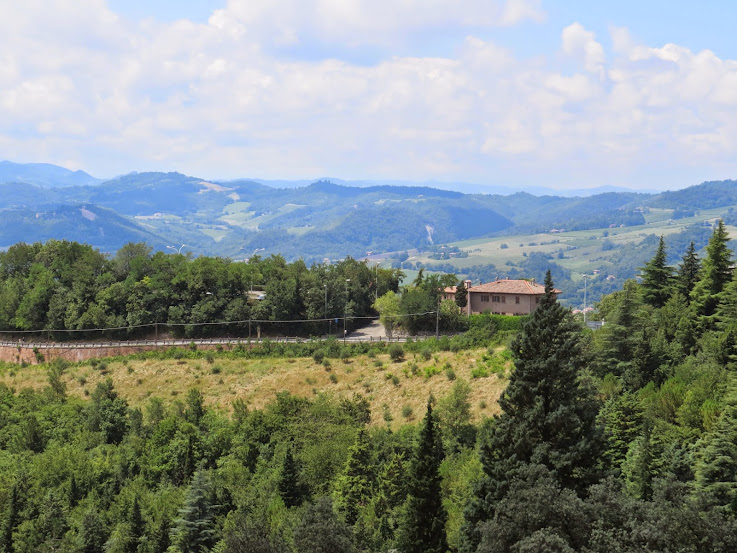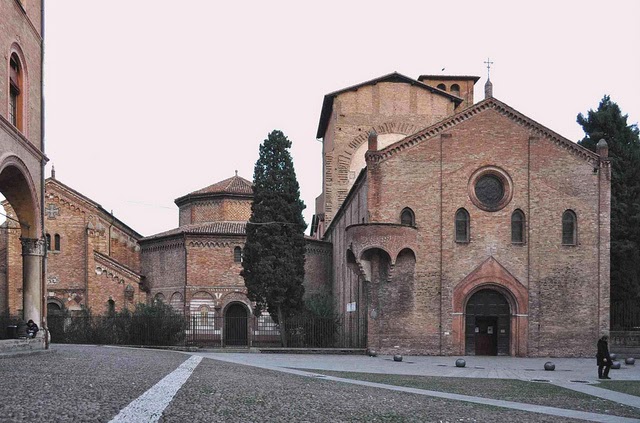We arrived in Bologna Thursday about lunch time. Our apartment contact didn't answer her phone, so we had lunch at a taverna across the street. Bruce had stuffed zucchini; Leslie had pasta with sausage sauce. Both were appreciated and enjoyed.
Our apartment for a few days is on a busy street in the old part of town.

After a nap to sleep off exhaustion and lunch, Bruce went to the local market and we had bread, cheese and wine in the garden.
Bologna is famous for its food. Recent reviews, however, warn that the high-end cuisine has left when an EU bureau moved away. There remains a huge number of small sidewalk places. The menus and prices from one to another are similar.
Fri, July 11
We ate the remnants of last night's bread for breakfast in our private garden.
Then, an overdue insurance bill set us off for the library to find a printer. The library is housed in the 18th century Salaborsa, or exchange.

Under the library, several layers of civilizations have been uncovered and displayed under the glass floor. They are mostly Roman Bononia founded in the 2nd century BCE.

After the library, we crossed Neptune Square,

and went to the Basilica San Petronio, started in 1390, finished 1670, façade not complete. The marble was taken from a Roman bridge, but there was not enough to do the job.
The Chapel of the Magi contains frescoes by Giovanni di Modena, One set is the visit of the Magi, who leave in boats
The other is last judgment with a Dantesque hell
According to the guide book, by the 5th century, the barbarian invasions had reduced Boninia (Roman Bologna) from a great city to a hamlet. Saint Petronius became bishop at this time and is credited with the building of San Stephano (tomorrow's post) and repairing other buildings. Little is known about him except for his bishopric and that he was probably a convert who visited Jerusalem. His relics were found in 1141 and a legendary life of him appeared. So far, I have been unable to find that legend. Also, he became patron saint of Bologna.
Dinner at the taverna across the street. Bruce craved greens and had a large salad. Leslie had pasta al ragu, known everywhere in the world as Bolognese.
Sat, July 12
Bologna is not a big tourist site and the tourists that are here are mostly Italians. We took the little tourist train and it was offered only in Italian.
Bologna is s college town, all over students, and has been for some time. The University was founded in 1088 and is the oldest university in continuous operation. In 1563, the "studium" was moved to a single building, the Archiginnasio Palace. Today we saw the jurisprudence space and the anatomical theater.
Note the high chair (under the canopy supported by two skinless figures) for the lecturer and the theater seats for the students. The main decoration of the building is pictures of past professors and thousands of coats of arms of students.
We went on to visit the Abbey of San Stefano, a complex complex of seven churches. It was a Benedictine Monastery. Now it is run by the Olivetans, which are within the Benedictine Confederation.
San Stefano seems to have little to do with San Stefano. You will recall San Petronio who had the abbey built from yesterday. His remains are here. The Church of the Crucifix has been stripped down to resemble the the medieval or Lombard look of the original church. The crypt contains the first two Bolognese martyrs, martyred under Diocletian, Vitale (tortured to death) and Agricola (crucified). They also have a basilica. There is a Basilica of the Holy Sepulchre, containing a copy of that structure. The complex also contains a Martyrium Church. A Martyrium is a burial ground for martyrs.
The construction is mostly brick. The builders used clays of different colors to get interesting effects.
Lunch fish, tortelli al ragu
Dinner: falafel and kebab in the flat
Sun, July 13
Bruce is in the mood for a long walk and Leslie wanted to rest her poor feet. Bologna it situated on the Pavian plain just in front of the hills and mountains that run down the spine of Italy. Since at least the 11th century, there has been a basilica on the hill where the Virgin of San Luca is kept. Each year the venerated icon moves in procession down the hill.
In the 17th century the path up the hill was put into a colonnaded arcade. It begins outside the Saragossa Gate...

PIC
... and continues through 660-odd arches to the 18th century basilica:




It was a beautiful day an the walk provides a wonderful recreation facility for the Bolognese.
The Madonna of St. Luke was supposed to be painted by the Evangelist and many miracles -- mostly of a meteorological type -- have been attributed. Recent research indicates that
the icon actually dates to the 11th century and it was overpainted in the 12th. Here's a copy in the small Museum:

Scientific investigations are encouraged by the Church and the results are widely publicized. Cf., http://en.wikipedia.org/wiki/Shroud_of_Turin . It does not dampen devotion to this site. Mass had overcrowded attendance.

Later we checked out the hotel we will move to tomorrow (or lease at the apartment run out). We spotted this sculpture of a vicious rabbit along the way:

No lunch. just lovely pastries.
Dinner at the tavern across the street: lasagna, pizza.








No comments:
Post a Comment